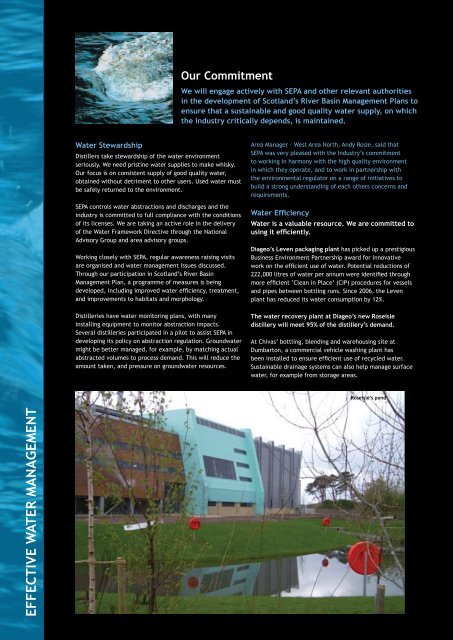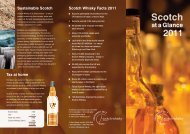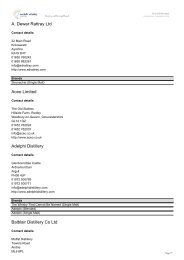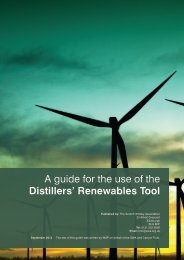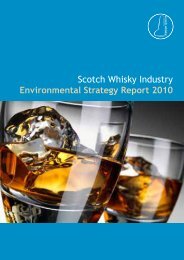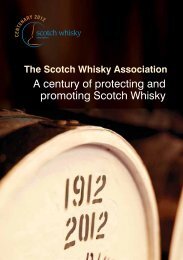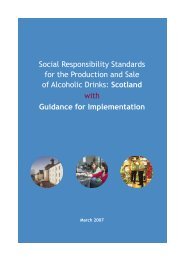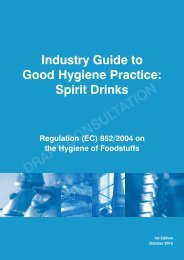Download the full case study - Scotch Whisky Association
Download the full case study - Scotch Whisky Association
Download the full case study - Scotch Whisky Association
You also want an ePaper? Increase the reach of your titles
YUMPU automatically turns print PDFs into web optimized ePapers that Google loves.
Our CommitmentWe will engage actively with SEPA and o<strong>the</strong>r relevant authoritiesin <strong>the</strong> development of Scotland’s River Basin Management Plans toensure that a sustainable and good quality water supply, on which<strong>the</strong> industry critically depends, is maintained.Water StewardshipDistillers take stewardship of <strong>the</strong> water environmentseriously. We need pristine water supplies to make whisky.Our focus is on consistent supply of good quality water,obtained without detriment to o<strong>the</strong>r users. Used water mustbe safely returned to <strong>the</strong> environment.SEPA controls water abstractions and discharges and <strong>the</strong>industry is committed to <strong>full</strong> compliance with <strong>the</strong> conditionsof its licenses. We are taking an active role in <strong>the</strong> deliveryof <strong>the</strong> Water Framework Directive through <strong>the</strong> NationalAdvisory Group and area advisory groups.Working closely with SEPA, regular awareness raising visitsare organised and water management issues discussed.Through our participation in Scotland’s River BasinManagement Plan, a programme of measures is beingdeveloped, including improved water efficiency, treatment,and improvements to habitats and morphology.Distilleries have water monitoring plans, with manyinstalling equipment to monitor abstraction impacts.Several distilleries participated in a pilot to assist SEPA indeveloping its policy on abstraction regulation. Groundwatermight be better managed, for example, by matching actualabstracted volumes to process demand. This will reduce <strong>the</strong>amount taken, and pressure on groundwater resources.Area Manager - West Area North, Andy Rosie, said thatSEPA was very pleased with <strong>the</strong> Industry’s commitmentto working in harmony with <strong>the</strong> high quality environmentin which <strong>the</strong>y operate, and to work in partnership with<strong>the</strong> environmental regulator on a range of initiatives tobuild a strong understanding of each o<strong>the</strong>rs concerns andrequirements.Water EfficiencyWater is a valuable resource. We are committed tousing it efficiently.Diageo’s Leven packaging plant has picked up a prestigiousBusiness Environment Partnership award for innovativework on <strong>the</strong> efficient use of water. Potential reductions of222,000 litres of water per annum were identified throughmore efficient ‘Clean in Place’ (CIP) procedures for vesselsand pipes between bottling runs. Since 2006, <strong>the</strong> Levenplant has reduced its water consumption by 12%.The water recovery plant at Diageo’s new Roseisledistillery will meet 95% of <strong>the</strong> distillery’s demand.At Chivas’ bottling, blending and warehousing site atDumbarton, a commercial vehicle washing plant hasbeen installed to ensure efficient use of recycled water.Sustainable drainage systems can also help manage surfacewater, for example from storage areas.Roseisle’s pondEFFECTIVE WATER MANAGEMENT
Managing Effluents ResponsiblyCopper stills are essential to whisky, uniquely influencing <strong>the</strong>spirit’s character. Above certain levels, however, copper maybe harmful to aquatic animals and plants. The industry workshard to minimise copper presence in discharges and it isessential to maintain that commitment.Working with Living Water, Wm Grant’s Glenfiddich distilleryin Dufftown has installed a natural, gravity-fed ecologicaltreatment system. The plant achieves overall biologicalremoval efficiencies in excess of 95%. The effluent hasresidual copper levels of less than 0.5 parts per million. As aSpecial Area of Conservation designated by Scottish Ministers,such actions are vital to protect <strong>the</strong> River Fiddich.The ecological system is planted with 16 native species ofwetland plants and willow trees, which bind copper onto <strong>the</strong>irroots, rhizomes or woody material, thus preventing its releaseinto <strong>the</strong> environment. Deer, ducks, foxes and red-leggedpartridges have all been spotted in <strong>the</strong> area. Similar wetlandshave been developed at Benrinnes (Diageo) and Glenallachie(Chivas Bro<strong>the</strong>rs) distilleries.The Edrington Group’s The Macallan distillery has installedan alternative technological solution to <strong>the</strong> same issue. Its ionexchange system – <strong>the</strong> result of a local industry demonstrationproject - removes copper from discharges. Spent lees from<strong>the</strong> stills are settled, passed through sand filters and tworesin ion exchange columns. Copper ions from solutionare exchanged for similarly charged ions attached to <strong>the</strong>immobile solid resin in <strong>the</strong> columns. The dissolved copperCopper removal plant at Macallanconcentration in <strong>the</strong> spent lees is reduced to just a fraction ofits original concentration at 0.2 parts per million. Recoveredcopper is used as a preservative for fence posts, whilst <strong>the</strong>resin can also be re-used.The collaboration demonstrated what can be achieved whencompanies work toge<strong>the</strong>r to achieve economies of scale butalso that <strong>the</strong> technology is only viable where effluent volumeis sufficient. The challenge is now to develop <strong>the</strong> technologycost effectively for smaller single distillery volumes.Reed Beds at Glenfiddich


